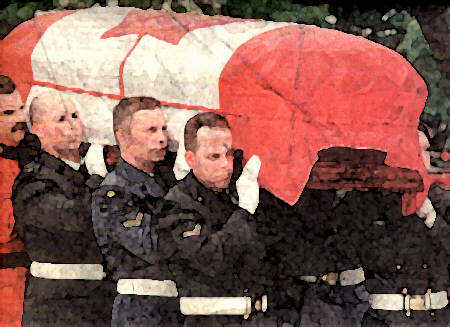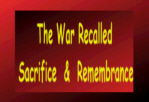
|
||||||||
Contributed by Joyce M. Kennedy
| ||||||||
A long-lost son came home [to Canada Thursday May 25, 2000] for a national wake and a military funeral. An Unknown Soldier, buried in France for more than 80 years, was placed in the Hall of Honour of the Parliament Buildings, to lie in state until a formal military funeral on Sunday.
"Dear God, we receive the remains of Canada's Unknown Soldier as a holy trust," Brig.-Gen. Murray Farwell, the chaplain general, said in a prayer as the remains were placed in Canadian care. The soldier had been buried under a gravestone bearing a Maple Leaf and the inscription: Known Unto God. It is rare for the Commonwealth War Graves Commission to grant permission to exhume a grave, and Canada had to agree never to try to identify the soldier before his remains could be brought home. On Sunday, the nameless, homeless, rankless soldier was be carried to his final resting place in a hand-hewn tomb of dark Caledonian granite at the foot of the National War Memorial. "Today is a solemn and moving moment in the history of our country," Defence Minister Art Eggleton said after a flag-shrouded coffin was carried from a grey military Airbus. He said the soldier "will forever represent the Canadian sacrifice for the restoration of peace and the defence of freedom in the past, the present and the future." The soldier symbolizes 27,000 comrades who have no known graves. Said Eggleton. "Although we know who they are, we know not where they lie:" On Sunday, [he was borne] through the streets of Ottawa on a century-old gun carriage drawn by four black RCMP horses. Honour guards with rifles reversed in mourning marched in front to the slow beat of drums muffled by black cloth. Minute guns boomed 21 times as the procession moved between lines of silent onlookers. Hundreds of veterans stood by the monument as the pallbearers - army, navy, 'air force and Mounties - positioned the silver maple coffin over the hand-hewn, Caledonian granite sarcophagus. It was draped in the Maple Leaf flag that this soldier never knew, a flag which, without him and his comrades, might never have been. Brig. Gen. Murray Farwell, the Roman Catholic chaplain-general, conducted the non-denominational service. He read from the 23rd Psalm: 'The Lord is my Shepherd, I shall not want:' and recited the words of Ecclesiastes:
Paul Metivier, a 100-year-old First World War vet and Ernest "Smoky" Smith, a Victoria-Cross winner of the Second World War, read the simple words of Laurence Binyon's Act of Remembrance: 'They shall not grow old, as we who are left grow old. Age shall not weary them, nor the years condemn. At the going down of the sun, and in the morning. We will remember them.
The material used in this article was gathered by Great War Society Member Joyce M. Kennedy, author of Distant Thunder: Canada's Citizen Soldiers on the Western Front. Several newspaper features were drawn upon most notably those of the Saskatoon, Saskatchewan Star Phoenix. |
||||||||

|
||||||||
|
||||||||




